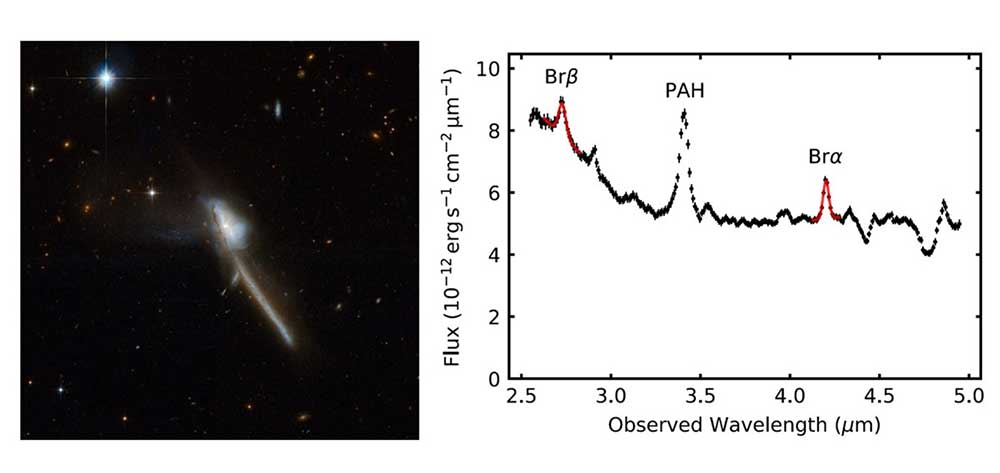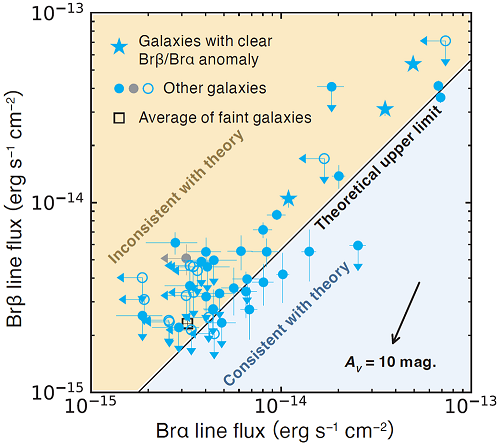AKARI’s discovery of an anomaly of hydrogen spectral lines in Ultra Luminous Infrared Galaxies; challenging theoretical predictions
Feb. 18, 2022 | GATEWAY to Academic Articles
It is one of the great tasks for astronomy to reveal star-formation activity in galaxies. For this purpose, hydrogen recombination lines have been used as one of the essential tools. However, our AKARI observations discovered an anomaly in the hydrogen spectral lines from Ultra Luminous Infrared Galaxies (ULIRGs); our observations showed that the ratio of two infrared recombination lines, Brβ and Brα, significantly exceeded the theoretically predicted value.
Our observations indicate that one of the basic assumptions for deriving the so-called “case B” theoretical values, which have been used widely in the past, does not apply to ULIRGs. It has been assumed that we would observe the Brα-line and Brβ-line photons emitted by hydrogen atoms without absorption from other hydrogen atoms. However, our observations indicate that many of the Brα-line photons radiated from hydrogen atoms near the center of the galaxies are absorbed by other hydrogen atoms near the surface of the galaxies and cannot reach us.
For this to happen, interstellar clouds in ULIRGs must have much higher (by more than a thousand times) densities than those in our Milky Way Galaxy. ULIRGs have been known to harbor bursts of star-formation, but the origins of the bursts have not been revealed clearly. Our AKARI observations suggest that the high-density clouds may cause the bursts of star-formation in ULIRGs.
Research Summary
A significant driver in the evolution of galaxies is the galactic star formation activity. As stars form out of clouds of hydrogen gas, hydrogen recombination lines*1 (a type of spectral lines*2) have been widely used as one of the essential tools for exploring star formation activity in galaxies. In particular, optical hydrogen recombination lines (for example, the Hα line at 0.656 µm) have been widely used because they can be observed easily. However, the optical hydrogen recombination lines are easily affected by interstellar extinction*3 caused by interstellar dust*4.
Therefore, in galaxies called ULIRGs (Ultra Luminous Infrared Galaxies) *5, which have bursts of star-formation activity and are rich in interstellar dust, the optical hydrogen recombination lines cannot uncover the actual picture of the star-formation activity. To reveal full pictures of star-formation activity in ULIRGs, we used the infrared astronomical satellite AKARI to observe infrared hydrogen recombination lines Brα (wavelength 4.05 µm) and Brβ (wavelength 2.63 µm), which are much less affected by interstellar extinction.
The observational results were surprising. According to the previous theoretical prediction (called case B*6), used widely in many studies, the two recombination lines' flux (Brβ / Brα) ratio has been predicted to be 0.565 or lower. However, some of the ULIRGs we observed had a ratio of about 1, much higher than the case B theoretical prediction.


We therefore suspect that one of the most basic assumptions to derive these widely used case B theoretical predictions cannot be applied to ULIRGs. It has been assumed that we would observe Brα-line and Brβ-line photons emitted by hydrogen atoms without being subject to absorption by other hydrogen atoms. However, our observed results indicate that many of the Brα-line photons radiated from hydrogen atoms near the center of the galaxies are absorbed by other hydrogen atoms near the surface of the galaxies and cannot reach us. We investigate this idea by model calculation, and find that the interstellar gas clouds in ULIRG with much higher (by more than 1000 times) densities than those in our Milky Way Galaxy can explain the observed results.
Thus, the observations by AKARI provide us with a new picture of star-formation activity in ULIRGs. It has been known that ULIRGs harbor bursts of star-formation activity, but it is still not clear what causes this activity. Our observations indicate that hydrogen gas clouds, which are raw materials for star-formation, are much denser in ULIRGs than in our Milky Way Galaxy. This high density might result in bursts of star-formation activity often observed in ULIRGs.
This paper is based on the Ph.D. dissertation by the first author Yano and is updated mainly by the second author Baba. We plan to make follow-up observations of this result using James Webb Space Telescope, launched last year.
Terminologies
- *1 Hydrogen recombination lines : A series of spectral lines*2 emitted by hydrogen atoms when their ions recombine with electrons. The Brα and Brβ lines used in this study correspond to the transition of the principal quantum number n from 5 to 4 and 6 to 4, respectively, and are in the infrared.
- *2 Spectral lines : Molecules, atoms, and ions have characteristics to emit or absorb radiation at specific wavelengths. Hence observed spectra have emission or absorption lines at specific wavelengths. The lines are called spectral lines.
- *3 Interstellar extinction : The phenomenon in which the emitted radiation becomes weaker by absorption or scattering by the interaction of the radiation and materials. Especially in the optical and infrared regions, interstellar extinction is mainly due to interstellar dust (see below). The effect is more prominent in the optical range than in the infrared wavelengths.
- *4 Interstellar dust : Solid dust particles in interstellar space. They strongly absorb and scatter optical radiation, producing interstellar extinction.
- *5 Ultra Luminous Infrared Galaxies (ULIRGs) : Very luminous galaxies (by more than 100 times our Milky Way Galaxy) with bursts of star-formation activity. They are faint in the optical but are very bright in the infrared. Large amounts of interstellar dust cause heavier interstellar extinction, and the true nature of ULIRGs has not been revealed yet.
- *6 Theoretical prediction (case B) : A theoretical model for the flux ratios of hydrogen recombination lines. The model was derived by Baker and Menzel (1938). They proposed three models, cases A, B, and C, and case B has been widely used to predict flux ratios. The case B model predicts the Brβ/Brα line ratio of 0.565. The Brβ line, whose wavelength is shorter than that of the Brα line, is more severely affected by interstellar extinction. Hence, the combination of case B and the interstellar extinction predicts the ratio of 0.565 or smaller--not as large as observed in the current study.
- *7 Polycyclic Aromatic Hydrocarbon (PAH) : A group of hydrocarbons consisting of multiple aromatic rings. Each aromatic ring has a hexagonal structure composed of six carbon atoms. PAHs are widely present in interstellar space and are regarded as a good tracer of star-formation activity because PAHs are excited mainly by ultraviolet radiation from young stars.
Information
| Journal Title | The Astrophysical Journal |
|---|---|
| Full title of the paper | Anomalous Hydrogen Recombination Line Ratios in Ultraluminous Infrared Galaxies |
| DOI | https://doi.org/10.3847/1538-4357/ac26be |
| Publish date | 06 December 2021 |
| Author(s) | Kenichi Yano, Shunsuke Baba, Takao Nakagawa, Matthew A. Malkan, Naoki Isobe, Mai Shirahata, Ryosuke Doi, Vanshree Bhalotia |
| ISAS or JAXA member(s) among author(s) | YANO Kenichi (Dept. of Physics, Graduate School of Science, University of Tokyo/ISAS), NAKAGAWA Takao (Dept. of Space Astronomy and Astrophysics. ISAS), ISOBE Naoki ( Dept. of Space Astronomy and Astrophysics. ISAS), SHIRAHATA Mai (ISAS), DOI Ryosuke ( Dept. of Physics, Graduate School of Science, University of Tokyo/ISAS) |


 NAKAGAWA Takao / Dept. of Space Astronomy and Astrophysics, ISAS
NAKAGAWA Takao / Dept. of Space Astronomy and Astrophysics, ISAS